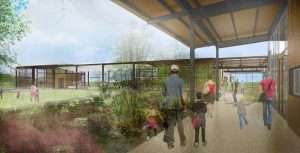Nancy Pappas
New Braunfels, Texas
Nancy Pappas is the Managing Director of New Braunfel Utilities‘s (NBU) Headwaters at the Comal, a 16-acre conservation legacy project whose mission is to strengthen the relationship between the community and nature by showcasing the significance of the Comal Springs. The project will create a premier education center inspiring hearts and minds on the importance of conservation to a community, a place where people can learn, have fun, experience nature and better understand the long history of people and the spring ecosystems of Texas. She has been employed by NBU since December 2016.
Currently, she serves on the following non-profit boards: The Institute for Public Health and Education Research (TIPHER), the Comal Trails Alliance, and Go Green Initiative. She is a Texas Water Leaders alumni and holds a Non-Profit Management Certification from OLLU, and an Envision Sustainability Professional. She is a graduate of Emory University with a Bachelor of Arts in Economics.
This interview was conducted by Carly Schmidt on January 10, 2020. Learn more about Headwaters at the Comal.
Can you tell me about Headwaters at the Comal and how this project came about?
Headwaters at the Comal is a 16-acre piece of property at the Headwaters Springs of the Comal River. The Comal River is the shortest river in Texas and it is really the heart and soul of the New Braunfels community. For many years, this property has been an important part of the water supply for the citizens of New Braunfels and it’s one of the original water sources since the community was settled in the 1800s. In 2014, when New Braunfels Utilities vacated the operations that were on this site, it had been a warehouse and operations facility. A master plan was created in conjunction with the community to re-purpose the site and restore it to more of its natural state. A building on site will become an environmental education center for the community. In order to get this project underway and collect funding, a 501c(3) non-profit was created to raise funds to support the center’s master plan. The non-profit organization also develops and operates the programs and educational offerings that happen on this site.

The vision for the Headwaters property. Photo via Headwaters at the Comal.
What kind of support have you seen from the community and local organizations for this build?
New Braunfels Utility has been a champion of this work, but you’re right, it takes a whole host of partners to do this work. In order to do the most important work of protecting and conserving the springs system, [New Braunfels Utility] took one section of the master plan which removed the asphalt and impervious pavement that was closest to the Springs from the property. New Braunfels Utilities provided the funding to get that done.
We also went into the community and had what we called the Foundation Builders campaign. We had over 300 distinct contributions made, but most importantly we had individuals and families participate who understand the importance of this river. We raised over $1 million in 90 days. This funding has allowed us to provide programs here and get locals and out-of-state visitors to learn about our Edwards Aquifer, native species, and what people can do to protect their local waters. The National Wildlife Federation is actually the group that partnered with us to get us involved with River Network! But I couldn’t begin to name all the groups who have supported this project in some way.
It sounds like the New Braunfels community is really connected to this spring system and recognizes the importance of it as one of their main water sources.
Yes, the river runs right through downtown New Braunfels. People tube it and use it for recreation and a lucky few get to live along its banks. But this headwaters area has been tucked in back here behind an industrial site. These headwaters springs were encased in concrete a cistern in the 1930s as part of a Works Progress Administration program and covered with a concrete cap. It was kind of forgotten until this project came to fruition. What we’ve been able to do is really open up this area to the community and get another level of engagement where it’s not just about tubing and recreation, but it’s really about understanding where this water comes from and how important it is to protect it. The Edwards Aquifer is a karst aquifer system so there’s a vast area where, when the rain falls, that water flows immediately and directly back into our aquifer. We’re helping people understand that the things they do upstream have a direct impact on the springs and the river.
What impact do you want this site to have long-term?
In the past year, we’ve really zoned in on that impact and we have four main areas where we hope to provide long-term impact. Certainly education and demonstration on this site is vital, inspiring a lifelong practice in stewarding and enjoying our springs. We also intend to protect and conserve this Comal Spring system and the endangered species it supports. We also look to partner in research and exploration of this site to connect what is happening here in New Braunfels with regional science. We hope that research will yield solutions to real-world problems like the tremendous growth that the Texas Hill Country is currently experiencing.
Something that’s really near and dear to my heart is the community engagement piece and providing a nature-oriented meeting and gathering place that instills an ethic of protecting our ecological and cultural resources. Mental health is such an important topic right now. Those of us who know and love being outside know how restorative it can be. We hope that we are also helping by providing a space for people to experience this beauty.
What are some of the challenges you are facing today to move this project forward?
Our biggest challenge right know, honestly, has been fundraising. In a growing community like New Braunfels there’s just a plethora of really important needs, so we are competing for those resources as far as funders and partners for our capital campaign.
What made your initial campaigns so successful at the outset of this project?
I think it was just understanding the need to protect and better understand these springs. Certainly the people who have lived here for generations have a deeper connection to this water source, but with the tremendous growth, not everyone understands or appreciates this incredible resource. It’s engaging that new community in these efforts to support water, birds, pollinators, and other creatures that are vital to this thriving ecosystem. That original outpouring of support showed the community interest. The engagement since has shown that people want to see this project developed. We need to take it to the next level and find that spirit of philanthropy to take this project to the next step.
What are your next steps?
We recognize that this is a long-term project. Some of our challenges with using the site right now are that we don’t have program space or sufficient restrooms, and we could use a bit more meeting area. Our next steps would be to develop our event space and add the stories about our archaeological history as part of this water story. We are engaging on that right now and we have a campaign underway. We hope to be able to raise the funds for this stage by the end of 2021, then we’ll roll right into future stages. This will be an ongoing project for a number of years, but we hope that this next stage will allow us to commit to field trips and big educational opportunities in the next two years.
UPDATE provided on Feb 19, 2025: Through continued community support an additional 5 million dollars has been raised and the Center at the Headwaters, a 6,400 square foot, multipurpose space, tree-shaded picnic area at the front entrance and a low impact demonstration parking area will be completed in late Fall 2025. The final phase of the master plan is anticipated to begin at that time and be completed by the end of 2026. Current funding needs are now around scaling the operations of the center and program expansion, including adding field trips for local area youth.







